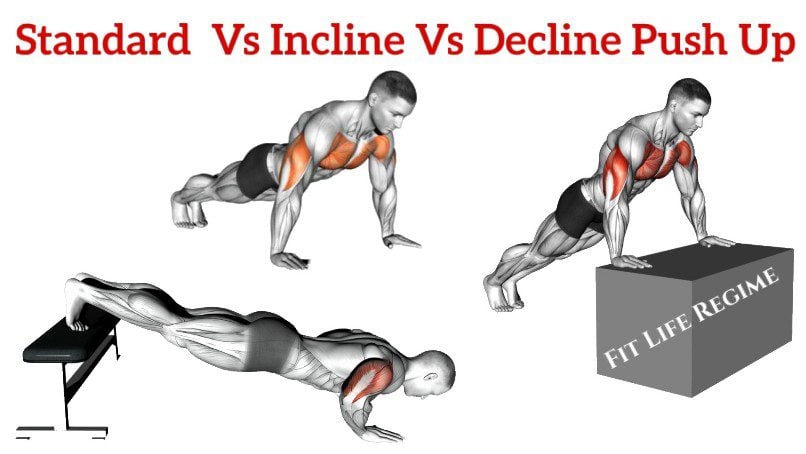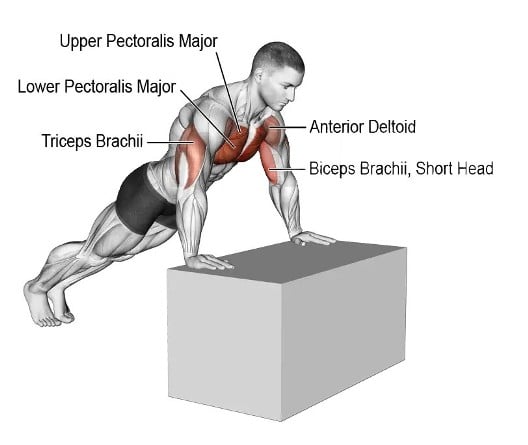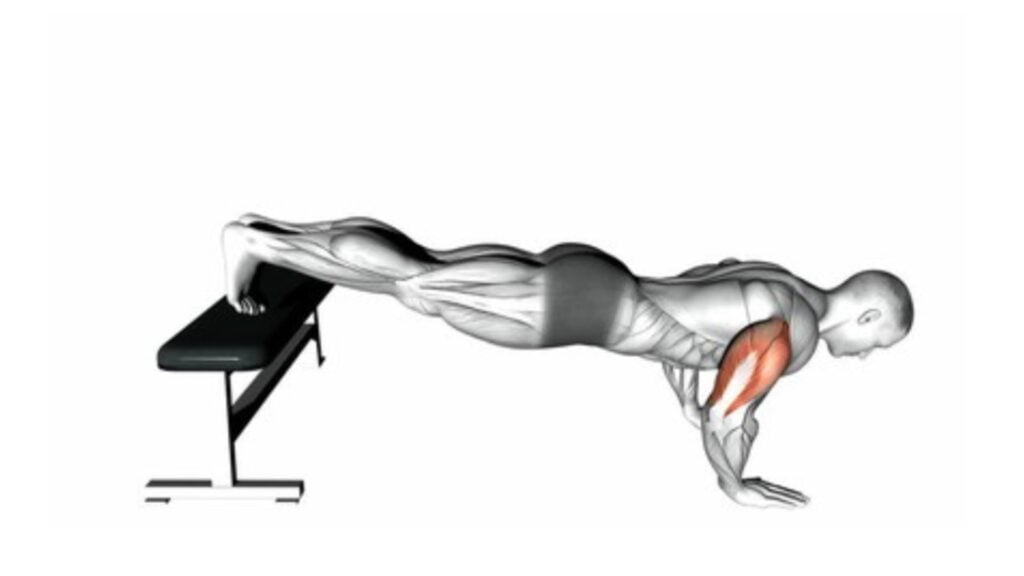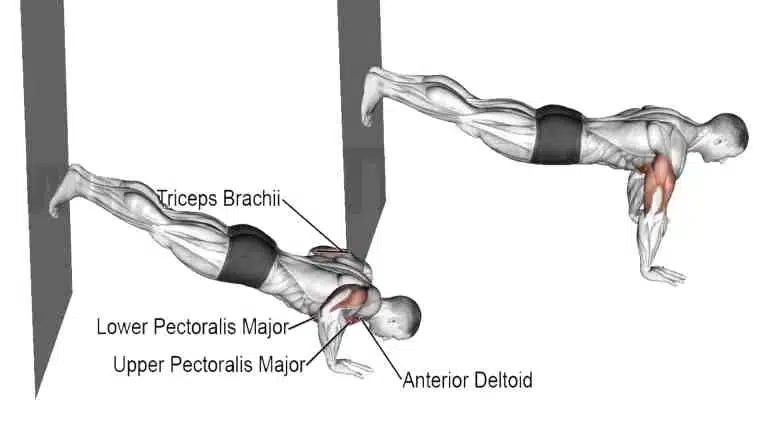Push-ups are a common upper body exercise that is easy to do and doesn’t require expensive equipment. They can be easily included in a fitness program. Push ups can be done in many different ways.
Push-ups can be modified to increase the strength and endurance of both men and women. They are used in programs for youth, general fitness, and military training. Teenagers to older adults can benefit from doing it regularly.
Even if you’re not in a gym, you can do push-ups. Best of all, they’re free. There are many different ways to do push-ups that can fit different needs.
There are three main variations of push that will be discussed.
- Standard Push Up
- Incline Push Up
- Decline Push Up

- Muscle Activation During Incline, Standard & Decline Push up
- Which Push Up Is Easier and More Difficult?
- Standard Push Up Vs Incline Push Up Vs Decline Push Up
- Incline Push-Up
- Incline Push Up Muscles Worked
- Standard Push-Ups
- Normal Push Up Muscles Worked
- Decline Push-Up
- Decline Push Up Muscles Worked
- Tips And Techniques For Standard, Incline and Decline Pushups
- Which Type Of Push Up Should You Do?
- Takeaways
- People Also Asked
- Do Decline Push Ups Work Upper Chest
- What Do Incline Push Ups Work
- Are Incline Push-Ups Easier Than Decline?
- Decline Push Up Vs Regular Push Up
- Incline Push Ups Vs Decline Push Ups
Muscle Activation During Incline, Standard & Decline Push up
Muscle activation of push-ups is typically examined through variations in hand placement and body placement, such as normal push-ups, incline, and decline push-ups. You can use these different types of push-ups to change up your fitness program and offer a range of low to high intensity options.
Standard Push-ups are a compound strength-training exercise that involves raising and lowering the body using the arms while facing down in a prone, horizontal position.
The normal push-up has survived the test of time and is the single most efficient exercise to simultaneously strengthen the chest, arms, deltoid, lower back, abs and glutes.
All three variations of the normal, incline, and decline push-up use your chest, triceps, shoulders, and core muscles. However, because of the angle, the Incline push up works your lower chest and core more.
On the other hand, The decline push up works the upper chest and front shoulders (delts) more than the regular or incline variation. If you’re looking to work your shoulders, you could try doing pike push-ups.
Want to take your gains to the next level? Discover your daily calorie needs with our free TDEE calculator
Which Push Up Is Easier and More Difficult?
If a standard push up is too hard, or you have trouble getting down to the floor, Incline pushups are the perfect compromise. The push up is easier if you are upright. The push will be ~50% easier if you have a 45-degree angle with your feet below your head, than if you have a horizontal angle.
Incline push-ups are easier than compared to the normal push-ups ones because of the angle at which the exercise has to be done. The incline surface means that more of the lower chest, shoulder muscles, tricep are used in incline push-ups.
Decline push-ups are harder than standard push-ups because of the angle at which the exercise has to be done. The decline position means that more of the upper chest, shoulder muscles, tricep are used in decline push-ups.
Standard Push Up Vs Incline Push Up Vs Decline Push Up
With a regular (normal) push-up, you are lifting about 64% of your own bodyweight.
When you do decline push ups, you push up more of your bodyweight, which makes the decline push up variation harder and more efficient than the Incline variation. Furthermore, the higher you place your feet, the harder it will be.
Incline push-ups are easier than compared to the normal push-ups ones because of the angle at which the exercise has to be done.
If you want to make incline pushups easier, place your hands on a wall or more inclined surface.
Incline Push-Up
The incline push up is a great bodyweight exercise that you can do to build your chest. It offers numerous benefits and is perfectly suited for both beginners and experienced athletes looking to build upper body strength.
The incline push up is a variation of the push-up where you push yourself off from a raised object instead of the ground.
You can also use objects like a chair, a gym bench, a sofa, a box, a sturdy table, or anything else.
Incline Push Up Muscles Worked
Depending on the degree to which you perform this exercise, it will be the muscles that are worked and with greater or lesser intensity. The main muscles involved in push-ups are:
- Main muscles during incline push ups: Lower Chest, Anterior deltoids (shoulder muscle), and triceps.
- Secondary muscles during incline pushups: The upper chest, lateral deltoid, serratus, trapezius, and core muscles

How To Do Incline Push-Up On Box
- Stand approximately 3 to 3.5 feet away from a low bench or sturdy chair.
- Reach forward and grab the sides of the chair or in front of the bench, keeping the balls of your feet in contact with the ground.
- Slowly lower yourself by flexing your elbows so that your chest comes within a few inches of the edge of the chair or bench.
- Using your hands, push yourself back to the starting position while focusing on maintaining a straight body position from head to ankle.
- The movement should be smooth and controlled.
Incline Pushups with hands on a ~30 cm box use 55% of your bodyweight.

Pushups with hands elevated on ~60 cm box – 41% of bodyweight
Standard Push-Ups
The standard push up is the popular type of push-up that to build your entire upper body, shoulders, chest, and arms.
Check how to do them correctly and blast your muscles at home or at the gym. This workout should be part of your push-ups arsenal.
Normal Push Up Muscles Worked
Depending on the degree to which you perform this exercise, it will be the muscles that are worked and with greater or lesser intensity. The main muscles involved in push-ups are:
- Main muscles during regular push ups: Chest, Anterior deltoids, and triceps.
- Secondary muscles during normal pushups: lateral deltoid, serratus, trapezius, and core muscles.
How To Do Standard Push-Ups
- Lay face down on the ground with your legs straight, and arms supporting your upper body. Keep your knees off the ground.
- Raise yourself off the ground, straightening your elbows and your arms.
- Raise until your elbows are locked, and pause for a moment at the top of the movement.
- Now, lower your body slowly and feel the motion all the way down until your chest is very close to the ground.
Regular push up (“standard” pushups) – 64% of bodyweight

Decline Push-Up
The Decline Push-up is a great exercise to start with if you want to train your upper chest with push ups at home.
It is similar to normal push-ups, but with your legs on a bench. Although this is called the decline push-up, it focuses more on the upper pecs.
Furthermore, your lower body is raised from the floor, the resistance your body provides is increased compared to doing the push-up on the floor. This makes the decline push-up harder than the standard push-up.
Decline Push Up Muscles Worked
Depending on the degree to which you perform this exercise, it will be the muscles that are worked and with greater or lesser intensity. The main muscles involved in push-ups are:
- Main muscles during decline push ups: Upper Chest, Anterior deltoids (shoulder muscle), and triceps.
- Secondary muscles during decline pushups: Lower chest, lateral deltoid, serratus, trapezius, and core muscles.

How To Do Decline Push-Up
- Placed your hands firmly on the floor and spaced slightly wider than shoulder-width apart. Put legs on the bench or the pad roller.
- Now raise yourself off the ground, straightening your elbows and your arms. Keep your elbows close to your body.
- Raise until your elbows are almost near to locked, and pause for a moment at the top of the movement.
- Now slowly lower your body until your chest is very close to the ground, feeling the motion all the way down.
- Complete 3-4 sets of 8 to 20 repetitions.
Decline Incline push ups with feet elevated on a 30 cm table (box) use 70% of your body weight.

Decline Pushups with feet elevated on 60 cm use 70% of their body weight.

So, the more of your body weight you have to move, the harder the push up variation will be. There is also a difference between core activation and other stuff, but that’s not as important.
Tips And Techniques For Standard, Incline and Decline Pushups
Follow the proper foam and techniques to get the most out of this move. Whether you’re doing traditional push-ups or an incline/decline variation, you can avoid these common mistakes to prevent ruining your gains and possibly injuring yourself. When going through your push-up sets, make sure you aren’t making these errors:
- For the push-ups, begin by performing 2–3 sets of 6–8 repetitions. Add more reps and sets as you build strength.
- Choose the exercises as per your fitness levels. And also choice your sets and repetitions based on your ability to maintain good technique throughout all sets and repetitions.
- Pay extra attention to your form and emphasize quality over quantity to improve your upper-body strength.
- When you’re in the high plank position for any push-up variant, you need to engage your glutes to make sure your spine doesn’t sag or bend.
- Don’t stop early, incomplete push-ups simply will not be as effective at growing muscle and functional strength.
- Your neck should be aligned with your body, not tilted up, which could strain the neck.
- If you are having trouble perfecting your form for this incline push up, it can be helpful to break down the movement, regress, and work on the foundation.
- To see continual progress and build body strength, incorporate proper warm-ups, rest, and nutrition into your exercise program.
- Slow down all of your movements and really stay focused on your form.
- Rest for 36 to 48 hours before training the same muscle groups to allow sufficient recovery.
Which Type Of Push Up Should You Do?
For a more well-rounded physique, you might consider using various push ups.
- Standard push ups are best for chest, shoulder and tricep.
- Incline Push Up works your lower chest and back more.
- On the other hand, the decline push-up works the upper chest and front shoulders more than the regular or incline variation.
- Close grip push-ups focus more on the tricep than the chest.
- Pike Push-ups focus more on shoulder than chest and tricep.
Takeaways
Push-ups are a compound strength-training exercise, and they are one of the greatest general conditioning exercises for the outdoor athlete. You can do them anywhere, no equipment required.
You can progress from incline push-ups with your hands raised to normal push up to decline push-ups with your feet raised. Embrace all kinds of push up variations.
People Also Asked
Do Decline Push Ups Work Upper Chest
The decline push up is one of the best pushups for the upper chest. You will be expected to decline at a certain angle in order to complete this move. The ‘declination’ helps target the upper chest muscles.
What Do Incline Push Ups Work
The incline position primarily works your lower chest muscles, but you’ll also need to engage your upper chest, shoulder, tricep and core muscles.
Are Incline Push-Ups Easier Than Decline?
Incline pushups are easier than regular or decline pushups. Due to the incline position, it reduces the amount of bodyweight you are lifting and puts less stress on your elbows.
The Incline push up is a great way to build your chest, shoulder, and tricep, and is perfect for beginners and pros.
Decline Push Up Vs Regular Push Up
When you do decline push ups, you lift more of your body weight, which makes the decline push up variation harder than the regular push-up variation.
A decline variation targets your upper chest and fronts of shoulders more aggressively than a regular push-up performed on level ground
Incline Push Ups Vs Decline Push Ups
Incline pushups are easier than basic pushups, while decline pushups are harder. The downward angle of a decline push up forces you to lift more of your body weight.
Both variations work your chest, triceps, shoulders, and back muscles. However, because of the angle, the Incline push up works your lower chest and back more.
On the other hand, the decline push-up works the upper chest and front shoulders more than the regular or incline variation.
Once you’ve mastered the incline and basic pushups, give the decline push up a shot. It is an excellent exercise for challenging your upper chest and shoulders.
References
- Ebben WP, Wurm B, Vanderzanden TL, et al. Kinetic analysis of several variations of push-ups. J Strength Cond Res 2011; 25: 2891–2894.
- Hollman JH, Stout JR. Comparison of Muscle-Activation Patterns During the Conventional Push-Up and Perfect· Pushup™ Exercises. The Journal of Strength and Conditioning Research. 2010 Dec;24(12):3352-62.
- Cogley RM, Archambault TA, Fibeger JF, Koverman MM. Comparison of muscle activation using various hand positions during the push-up exercise. Journal of strength and conditioning research. 2005 Aug 1;19(3):628.

Manish brings over 10 years of hands-on experience in weight lifting and fat loss to fitness coaching. He specializes in gym-based training and has a lot of knowledge about exercise, lifting technique, biomechanics, and more.
Through “Fit Life Regime,” he generously shares the insights he’s gained over a decade in the field. His goal is to equip others with the knowledge to start their own fitness journey.
